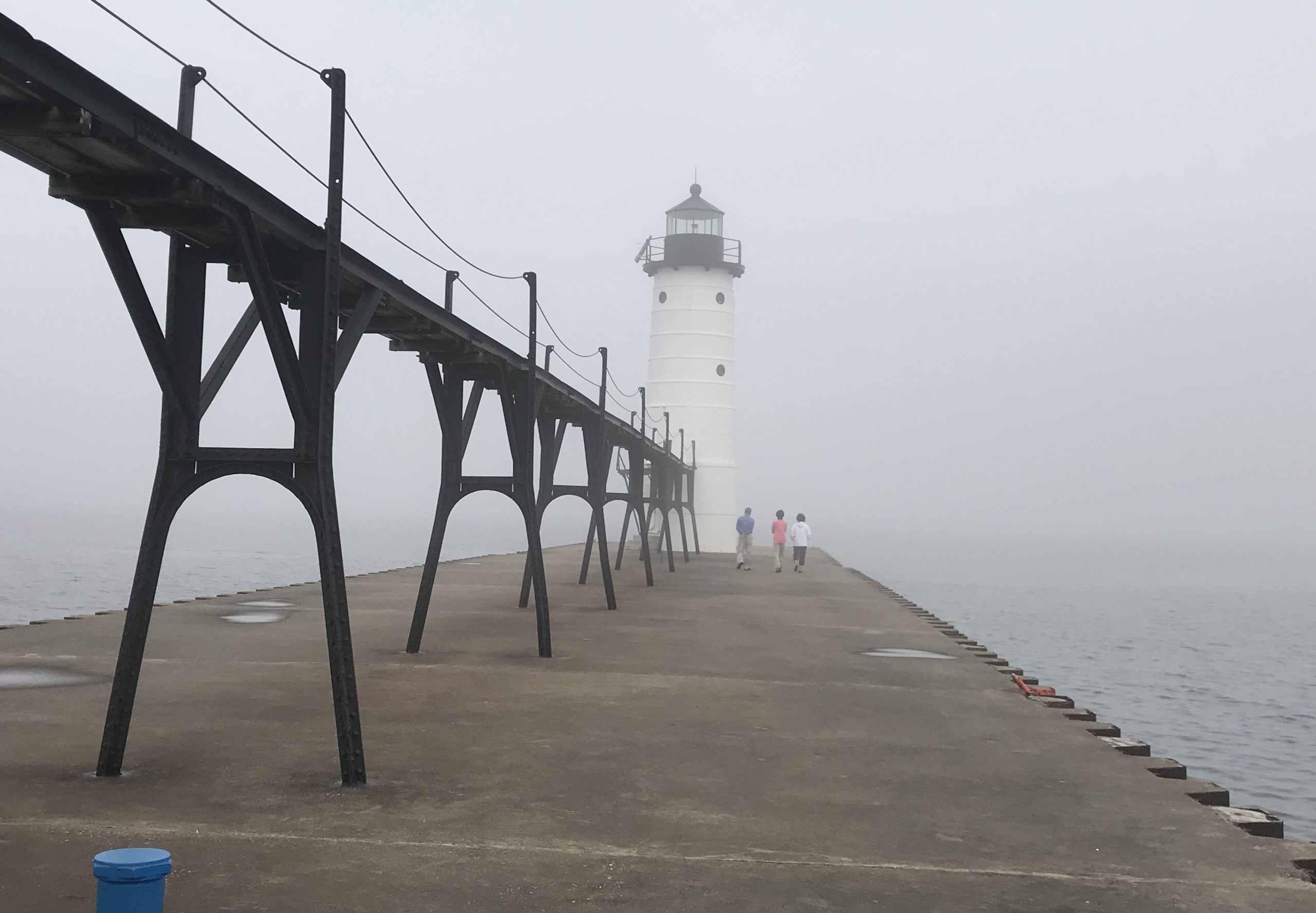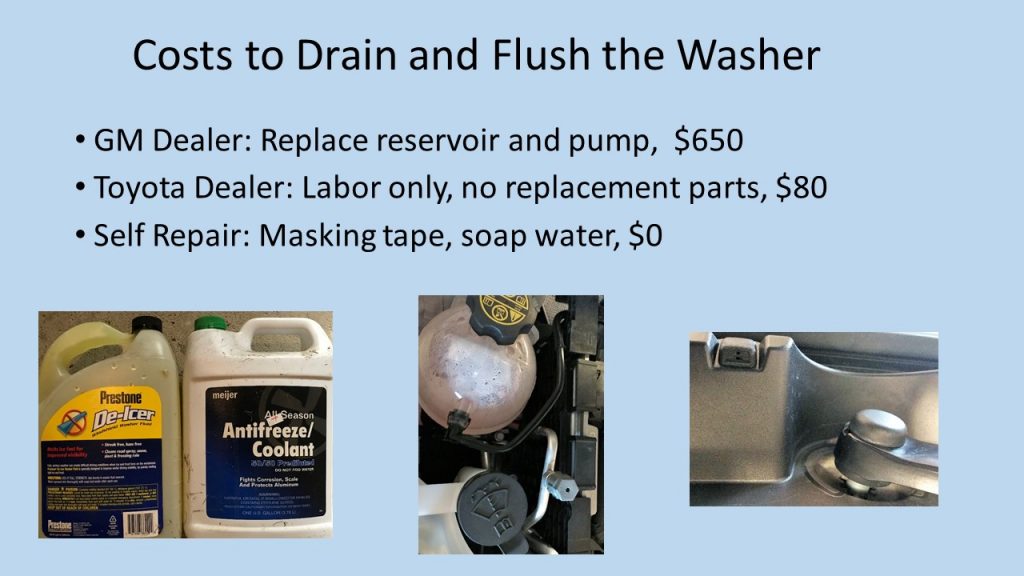
137. Story of Windshield Washer Repair | 一則雨刷儲液罐維修的故事
– Musings of Dr. Jamie C. Hsu, 5.20.2022
My wife and I encountered an interesting experience when trying to repair the windshield washer fluid in our cars. A GM dealer would have charged us $650, a Toyota dealer charged us $80, and we ultimately did it ourselves for $0. Here is the story and the lessons learned.
Before our car trip last week, I hastily poured liquid into the windshield washer reservoir of our Toyota RAV4 and Buick Encore, but I made a careless mistake. I poured antifreeze coolant instead of washer fluid. Only when we encountered rain on our trip home did I use the wipers and squirt the liquid on the windshield. The windshield was covered with foamy antifreeze coolant, and the splash got on the roof and the side windows. That was when I realized the mistake I had made.
First, I took the Buick Encore to a GM dealer and asked if they could drain the antifreeze and flush the reservoir. The answer was “no” because the fluid is sticky and not easy to clean out. In addition, they thought both the reservoir and motor may have been damaged. Just to be safe, the whole windshield fluid system had to be replaced at a cost of $650. That was a shocker. I decided to see what a Toyota dealer would do on the Toyota RAV4. The technician there took apart the reservoir, drained it, and flushed the system with warm soapy water until it was totally free of antifreeze. The total cost was $80. This is a good example of the difference between the more American approach of “just in case” and “replace instead of repair,” as compared to the Japanese approach of “just as needed” and “minimal waste.” It is sad to see that after decades of “learning the Toyota System,” GM dealers have not yet mastered the lean approach.
Back at home, we decided to clean and flush the Buick by ourselves. The challenge was doing this without the special tools required to take down the reservoir and pump. We knew that if we just squirted the fluid out to empty the system, the antifreeze would create a sticky film on the windshield and car body. That would have cost us a couple hundred dollars for a special cleaning.
After some trials and discussions with my wife, we found that we could use masking tape to block the windshield squirting nozzles and just let the fluid ooze out without any splashing. This prevented the fluid from touching the windshield or car body. In the end, we successfully drained and flushed the system with $0 spent.
Our lessons learned: observing, experimenting, and a lean mindset pay off nicely.

一則雨刷儲液罐維修的故事 (2022/05/20)
-作者 許俊宸博士
-中譯 薛乃綺
在我修理車上雨刷儲液罐時,遇到了一個有趣的事情。GM經銷商要向我們收650美金、Toyota收了80美金、我們自己做則是不用花錢。這次的經历可說是經一事長一智。
在我們上周自駕出遊之前,我匆忙中犯了個愚蠢的錯誤,把不對的液體倒進家裡Toyota跟Buick兩台車的雨刷儲液罐中。我把防凍冷卻液倒了進去,而不是清潔液。回程時遇到下雨,我才第一次用了雨刷、把清洗液噴到擋風玻璃上。結果擋風玻璃滿是防凍冷卻液的泡沫,還飛濺到車頂跟兩邊的車窗上。直到此時,我才意識到我倒錯東西了。
我先把Buick Encore開倒GM的經銷商店裡,問他是否可以清掉防凍冷卻液、然後清洗雨刷的儲液罐。結果是”不行”,因為冷卻液很黏、不容易清洗。此外,他們還評估水箱跟马达機電設備恐怕已經有損壞。為了安全起見,建議整個擋風玻璃系統需要全部進行更換,費用是650美金。這實在太令人感到震驚!於是我決定看看Toyota RAV4那邊怎麼說。那邊的技術人員,拆開了水箱、排乾了水、並且用溫的肥皂水沖洗,直到冷卻劑整個被清洗乾淨。這樣要80美金。這是個很好的例子,說明美國典型的“以防外一”以及”更換不維修” 的作法、跟日本的”依照需要”以及”降低到最少浪費”作法的區別。遺憾的是,經過數十年效法豐田系統,GM汽車的經銷商仍然沒能掌握所謂精實管理。
回到家後,我決定自己來清潔沖洗Buick那台車。挑戰在於沒有拆除水箱跟泵所需要的工具這件事情上。我們知道,如果只是把液體噴出來淨空整个系統,那冷卻劑會在擋風玻璃和車身上形成一層薄薄的黏液。如此一來我就要花費幾百塊美金來做特殊的清潔處理。
經過跟我太太的一些實驗跟討論後,我們發現可以用遮蔽膠帶把擋風玻璃的噴嘴給堵住一半,讓液體滲出來而不會噴濺出其他東西。這樣可以防止液體接觸到擋風玻璃跟車身。所以,我們自己沒有花錢並且成功地排空了系統。
我們吸取了經驗和教訓:觀察、實驗,和精實的思維,能夠得到很好的回饋!


